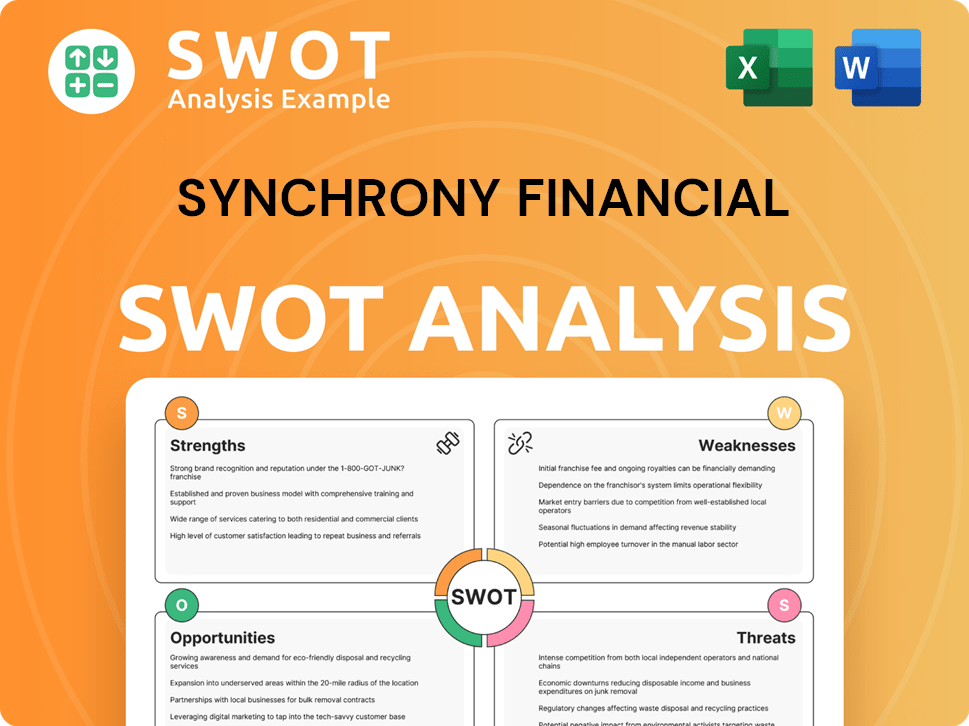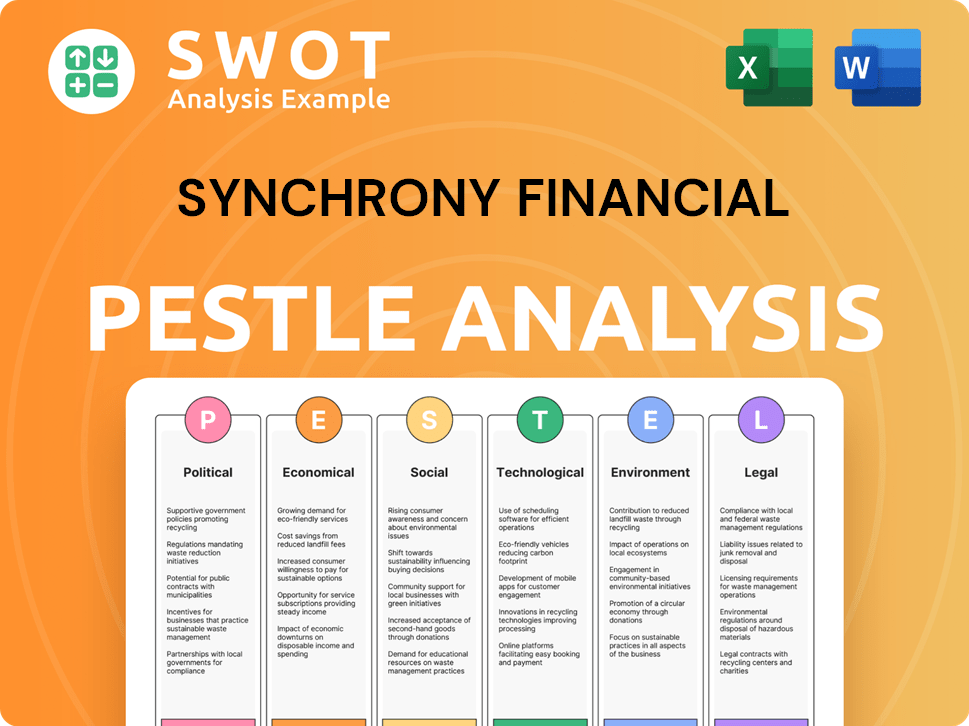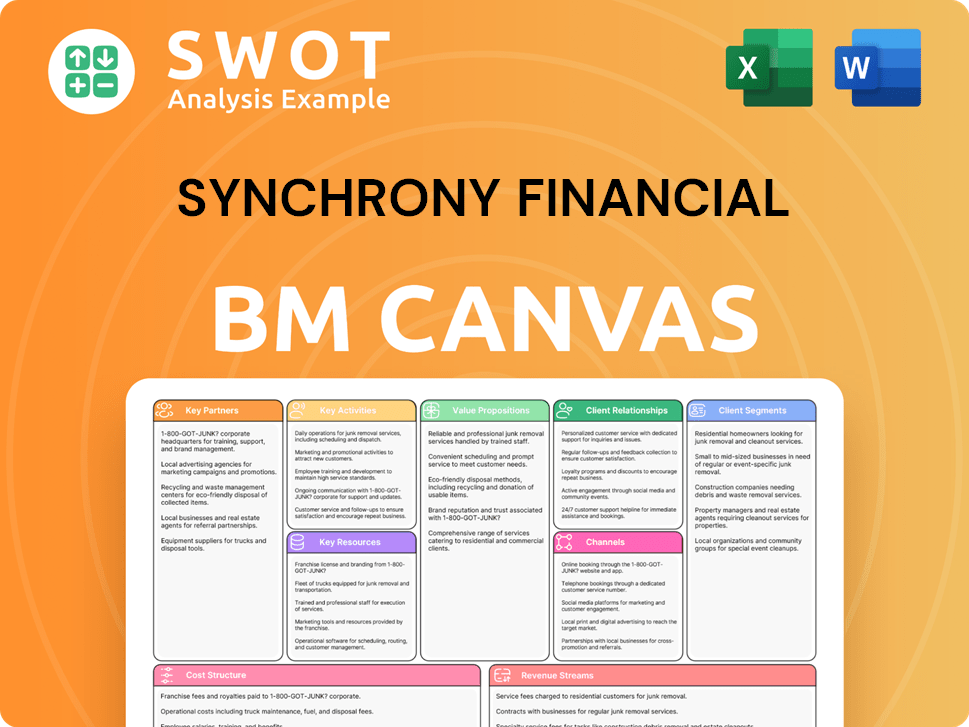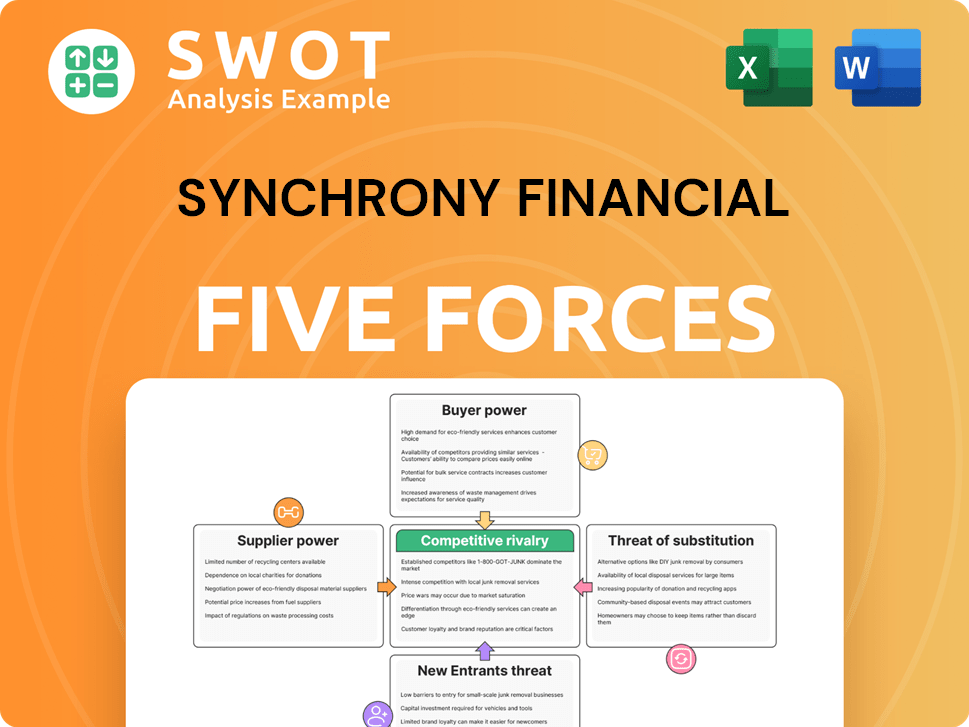Synchrony Financial Bundle
What's Next for Synchrony Financial?
Synchrony Financial, a key player in the financial services sector, has carved a niche through its strategic partnerships and specialized credit products. Born from GE Capital, the company has grown into a financial powerhouse, serving millions with flexible financing solutions. Understanding its growth strategy and future prospects is crucial for anyone looking to navigate the ever-changing financial landscape.

As Synchrony Financial continues to evolve, its focus on strategic expansion and innovation is paramount. The company's Synchrony Financial SWOT Analysis provides valuable insights into its strengths and weaknesses, as well as opportunities and threats. With a keen eye on market trends and customer needs, Synchrony Financial aims to solidify its position and drive sustainable financial performance, making it a compelling case study for company analysis and future growth opportunities in the financial services industry.
How Is Synchrony Financial Expanding Its Reach?
Synchrony Financial's Growth Strategy is heavily influenced by its expansion efforts. These initiatives focus on strengthening existing partnerships and forming new alliances across various sectors. By strategically expanding its reach, the company aims to tap into new customer segments and diversify its revenue streams. This approach is crucial for staying competitive and adapting to the evolving financial services landscape.
In 2024, Synchrony added over 45 new partners, demonstrating its commitment to growth. These partnerships include notable brands like Virgin, Gibson, and BRP. The company also renewed key agreements with established partners such as Sam's Club and JCPenney. This continuous expansion highlights Synchrony’s proactive approach to growth and market penetration.
Synchrony continues to focus on sectors that demonstrate resilience, including home, auto, and healthcare. This is evidenced by new alliances in Q1 2025, like the one with Texas A&M Veterinary Hospital and Sun Country Airlines. These strategic collaborations are designed to ensure the company's long-term success by adapting to industry changes.
Synchrony is actively expanding its digital ecosystem to enhance customer engagement. The Synchrony Marketplace, which connects consumers with partners, is a key component of this strategy. This digital focus is critical for meeting evolving consumer preferences and boosting purchasing power.
The Synchrony Marketplace saw nearly 228 million customer visits in 2024. This platform drove over 17% growth in newly submitted applications. These numbers highlight the effectiveness of Synchrony's digital initiatives in attracting and retaining customers.
Synchrony's digital wallet strategy achieved significant progress in 2024. There was an 85% increase in unique active users. Digital wallet sales more than doubled compared to 2023, showcasing the success of these digital advancements.
Synchrony offers its own 'buy now, pay later' option through Clover. This expansion of product offerings caters to evolving consumer payment preferences. This strategic move enhances Synchrony's competitive position in the financial services market.
Synchrony Financial's Growth Strategy hinges on strategic partnerships and digital innovation. The company’s focus on expanding its network and enhancing its digital capabilities is designed to drive revenue growth and improve customer engagement. This approach is crucial for navigating the dynamic Marketing Strategy of Synchrony Financial and securing future growth opportunities.
- Expansion of partnerships across diverse sectors.
- Growth in digital wallet usage and sales.
- Introduction of 'buy now, pay later' options.
- Focus on resilient sectors like home, auto, and healthcare.
Synchrony Financial SWOT Analysis
- Complete SWOT Breakdown
- Fully Customizable
- Editable in Excel & Word
- Professional Formatting
- Investor-Ready Format

How Does Synchrony Financial Invest in Innovation?
The strategic use of technology and innovation is central to Synchrony Financial's approach to achieving sustained growth in the competitive financial services sector. The company's commitment to digital transformation is evident in the significant expansion of its digital wallet strategy. This focus allows the company to adapt quickly to changes in the financial landscape.
Synchrony's ability to offer tailored financing solutions through digital channels is a key driver of its growth objectives. This approach helps the company reach the right customers in their preferred ways. The company's investment in its 'dynamic technology platform' helps maintain a balanced approach to underwriting and credit management.
Synchrony Financial's digital wallet strategy saw an impressive increase, with an 85% rise in unique active users in 2024. This growth effectively doubled digital wallet sales. This indicates the company's successful penetration into the digital payments space and its ability to provide seamless, omnichannel experiences.
Synchrony Financial is actively pursuing digital transformation to enhance customer experiences and operational efficiency. This involves investments in digital platforms and capabilities to meet evolving customer preferences.
The company's 'dynamic technology platform' is a core strength, enabling rapid adaptation to changes in the consumer finance landscape. This platform supports a balanced approach to underwriting and credit management.
Synchrony focuses on providing seamless, omnichannel experiences to its customers. This includes offering tailored financing solutions through preferred channels, which contributes to growth.
The company's digital wallet strategy is a key area of innovation, with significant growth in unique active users. This expansion highlights Synchrony's success in the digital payments space.
Synchrony continuously invests in its technology platform to support its growth strategy. These investments are crucial for maintaining a competitive edge in the financial services market.
Synchrony uses data analytics to make informed decisions about underwriting, credit management, and customer engagement. This data-driven approach helps optimize its operations and improve customer outcomes.
Synchrony Financial's approach to technology and innovation is critical to its growth strategy. The company focuses on digital transformation, customer experience, and strategic investments to stay competitive. The company's digital wallet strategy is a key area of innovation, with significant growth in unique active users. This expansion highlights Synchrony's success in the digital payments space. For more insights into Synchrony Financial's performance, consider reading about Owners & Shareholders of Synchrony Financial.
- Digital Wallet Expansion: Significant growth in unique active users, demonstrating successful penetration into the digital payments market.
- Dynamic Technology Platform: Continuous investment in a platform that allows for rapid adaptation to the evolving consumer finance landscape.
- Omnichannel Experiences: Focus on providing seamless experiences across all channels, enhancing customer satisfaction and loyalty.
- Data Analytics: Leveraging data to make informed decisions in underwriting, credit management, and customer engagement.
- Strategic Investments: Ongoing investments in technology and innovation to maintain a competitive edge in the financial services industry.
Synchrony Financial PESTLE Analysis
- Covers All 6 PESTLE Categories
- No Research Needed – Save Hours of Work
- Built by Experts, Trusted by Consultants
- Instant Download, Ready to Use
- 100% Editable, Fully Customizable

What Is Synchrony Financial’s Growth Forecast?
The financial outlook for Synchrony Financial in 2025 reflects strategic planning amidst changing economic conditions. The company anticipates net revenue to be between $15.2 billion and $15.7 billion for the full year 2025, following approximately $16.13 billion in net revenue for 2024. This projection suggests a focus on maintaining financial stability and adapting to market dynamics.
Synchrony Financial's strategic initiatives, including a focus on digital transformation and expansion plans, are key to its future growth opportunities. The company's ability to navigate the competitive landscape and leverage its credit card offerings will be crucial. Understanding the Target Market of Synchrony Financial is essential for assessing its growth strategy.
In the first quarter of 2025, Synchrony demonstrated strong performance, with net earnings of $757 million, or $1.89 per diluted share. This exceeded analysts' expectations, resulting in a return on average assets of 2.5% and a return on tangible common equity of 22.4%. Despite a reported 23% year-over-year decrease in net revenue to $3.7 billion in Q1 2025, adjusted net earnings increased significantly, indicating resilience.
Synchrony projects net revenue between $15.2 billion and $15.7 billion for 2025. The company anticipates low single-digit growth in loan receivables for the year. This suggests a cautious approach to expansion, focusing on sustainable growth.
The net interest margin expanded by 19 basis points to 14.74% in Q1 2025. This improvement was driven by lower interest-bearing liabilities costs. This expansion demonstrates effective financial management and cost control.
Synchrony's Common Equity Tier 1 (CET1) ratio was 13.2% as of March 31, 2025, indicating a strong balance sheet. The company's Board approved a new capital plan, including $2.5 billion in share repurchases through June 30, 2026, and a 20% increase in the quarterly cash dividend to $0.30 per share, starting in Q2 2025.
Net earnings for Q1 2025 were $757 million, or $1.89 per diluted share. Adjusted net earnings, excluding the Pets Best gain, rose 54% year-over-year. This highlights the company's operational strength and ability to deliver shareholder value.
Synchrony Financial Business Model Canvas
- Complete 9-Block Business Model Canvas
- Effortlessly Communicate Your Business Strategy
- Investor-Ready BMC Format
- 100% Editable and Customizable
- Clear and Structured Layout

What Risks Could Slow Synchrony Financial’s Growth?
The path to growth for Synchrony Financial is not without its challenges. The financial services sector is highly competitive, and Synchrony Financial faces numerous obstacles that could impact its Growth Strategy and Future Prospects. These risks range from market dynamics to regulatory changes and economic uncertainties.
Company Analysis reveals that Synchrony Financial must navigate a complex landscape. This requires a proactive approach to risk management and strategic adaptation to maintain its financial performance. Understanding these potential pitfalls is crucial for assessing the Synchrony Financial's long-term viability.
Market Trends indicate that Synchrony Financial operates in a dynamic environment. Competition is fierce, and the company must constantly innovate and adapt to maintain its position.
Synchrony Financial competes with traditional banks and credit card issuers. The rise of non-traditional providers like PayPal adds further pressure. In Q1 2025, Synchrony Financial's revenue decreased by 15.12% year-over-year.
Changes in regulations, especially regarding late fees, could significantly affect revenue. The Consumer Financial Protection Bureau (CFPB) has broad authority over Synchrony Financial. Regulatory actions could adversely impact the company.
Persistent inflationary pressures impact consumer spending. Purchase volumes decreased by 4% in Q1 2025 to $40.7 billion. Ending loan receivables also declined by 2% to $100 billion.
Synchrony Financial's net charge-offs rose slightly to 6.38% in Q1 2025. The company is working to return to its long-term net charge-off target of 5.5% to 6.0%. Delinquency formation is improving.
Synchrony Financial faces strong competition from established financial institutions and fintech companies. The company needs to differentiate its offerings to maintain its market share. The loss of market share to approximately 1.47%
Changes in consumer behavior and technological advancements pose operational risks. Synchrony Financial must adapt its business model to stay relevant. Any disruption in the market can impact the Synchrony Financial.
Synchrony Financial employs disciplined risk management practices. The company has adjusted its credit actions since mid-2023 through early 2024. These actions are improving delinquency formation. The company is focused on returning to its long-term net charge-off target.
Synchrony Financial maintains a strong balance sheet. The CET1 ratio was 13.2% as of March 31, 2025. This strong capital position provides a buffer against potential credit losses. The company's strong financial position supports its strategies.
Synchrony Financial strategically focuses on resilient sectors. The company has renewed key partnerships to offset macroeconomic headwinds. These strategic initiatives are designed to mitigate risks and support growth.
Synchrony Financial must navigate intense market competition. The company must adapt to regulatory changes and economic uncertainties. For a more in-depth understanding of Synchrony Financial's strategies and performance, consider reading about the company's [financial performance and strategic initiatives](0).
Synchrony Financial Porter's Five Forces Analysis
- Covers All 5 Competitive Forces in Detail
- Structured for Consultants, Students, and Founders
- 100% Editable in Microsoft Word & Excel
- Instant Digital Download – Use Immediately
- Compatible with Mac & PC – Fully Unlocked

Related Blogs
- What are Mission Vision & Core Values of Synchrony Financial Company?
- What is Competitive Landscape of Synchrony Financial Company?
- How Does Synchrony Financial Company Work?
- What is Sales and Marketing Strategy of Synchrony Financial Company?
- What is Brief History of Synchrony Financial Company?
- Who Owns Synchrony Financial Company?
- What is Customer Demographics and Target Market of Synchrony Financial Company?
Disclaimer
All information, articles, and product details provided on this website are for general informational and educational purposes only. We do not claim any ownership over, nor do we intend to infringe upon, any trademarks, copyrights, logos, brand names, or other intellectual property mentioned or depicted on this site. Such intellectual property remains the property of its respective owners, and any references here are made solely for identification or informational purposes, without implying any affiliation, endorsement, or partnership.
We make no representations or warranties, express or implied, regarding the accuracy, completeness, or suitability of any content or products presented. Nothing on this website should be construed as legal, tax, investment, financial, medical, or other professional advice. In addition, no part of this site—including articles or product references—constitutes a solicitation, recommendation, endorsement, advertisement, or offer to buy or sell any securities, franchises, or other financial instruments, particularly in jurisdictions where such activity would be unlawful.
All content is of a general nature and may not address the specific circumstances of any individual or entity. It is not a substitute for professional advice or services. Any actions you take based on the information provided here are strictly at your own risk. You accept full responsibility for any decisions or outcomes arising from your use of this website and agree to release us from any liability in connection with your use of, or reliance upon, the content or products found herein.